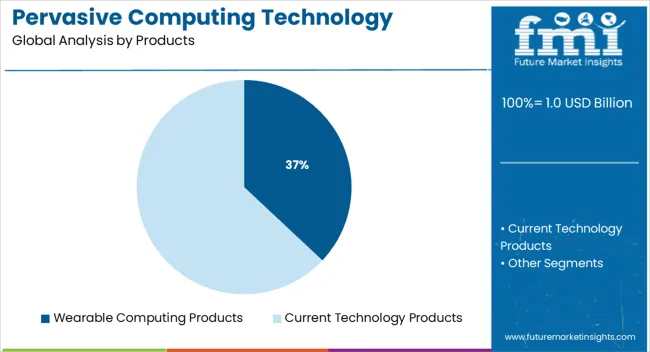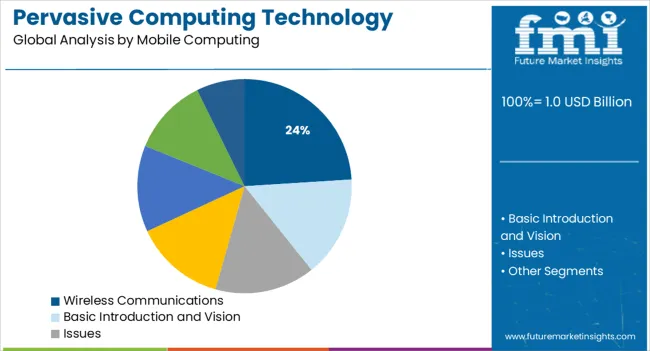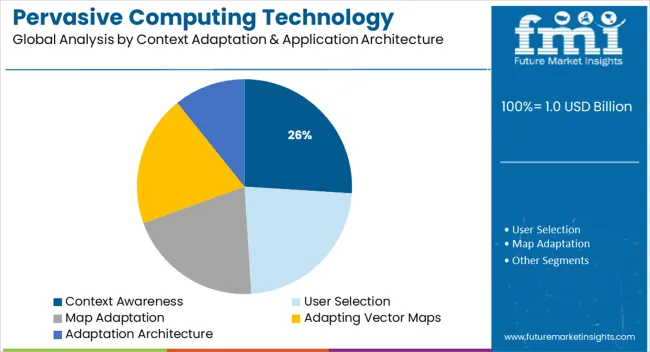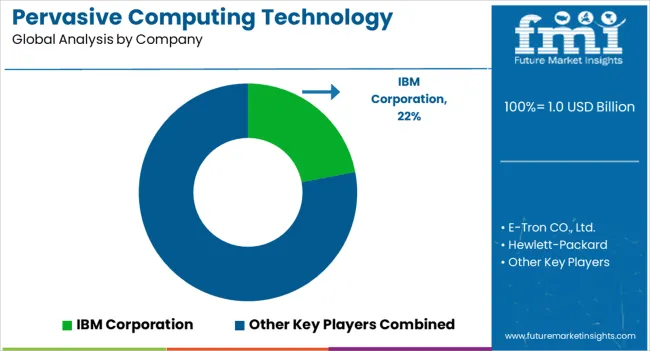The Pervasive Computing Technology Market is estimated to be valued at USD 1.0 billion in 2025 and is projected to reach USD 5.8 billion by 2035, registering a compound annual growth rate (CAGR) of 19.9% over the forecast period.

| Metric | Value |
|---|---|
| Pervasive Computing Technology Market Estimated Value in (2025E) | USD 1.0 billion |
| Pervasive Computing Technology Market Forecast Value in (2035F) | USD 5.8 billion |
| Forecast CAGR (2025 to 2035) | 19.9% |
The pervasive computing technology market is advancing steadily, supported by increased demand for real-time data processing, seamless connectivity, and intelligent user experiences across industries. Enterprises and governments are increasingly integrating context-aware systems to drive automation, improve decision-making, and enhance service delivery.
The convergence of ubiquitous wireless access, edge computing, and miniaturized sensors is enabling pervasive technology deployment across consumer, industrial, and healthcare environments. A shift toward hyper-connected infrastructure, catalyzed by smart city initiatives and digital transformation roadmaps, is expanding the scope of context-adaptive computing solutions.
Continued investments in 5G, AI integration, and low-power embedded systems are projected to accelerate product innovation and cross-platform adoption. Regulatory focus on interoperability and data security is further shaping the evolution of scalable, adaptive computing architectures across sectors.
The market is segmented by Products, Mobile Computing, Context Adaptation & Application Architecture, Intelligent Environment, and Applications and region. By Products, the market is divided into Wearable Computing Products and Current Technology Products. In terms of Mobile Computing, the market is classified into Wireless Communications, Basic Introduction and Vision, Issues, Wireless Problem, Ad-Hoc Networking, Ad-Hoc Network Applications, and Ad-Hoc Collaborative Working and Integration of Mobile System.
Based on Context Adaptation & Application Architecture, the market is segmented into Context Awareness, User Selection, Map Adaptation, Adapting Vector Maps, and Adaptation Architecture. By Intelligent Environment, the market is divided into Smart Dust Technology, Future Smart Dust, Pervasive Computer Problems, Scaling Factors, and Vision-Based Interaction.
By Applications, the market is segmented into Mobility and Networking, Security, Privacy and Management, Information Access, Text Retrieval, Multimedia Document Retrieval, Speech Recognition, Gesture Recognition, and Others. Regionally, the market is classified into North America, Latin America, Western Europe, Eastern Europe, Balkan & Baltic Countries, Russia & Belarus, Central Asia, East Asia, South Asia & Pacific, and the Middle East & Africa.

Wearable computing products are projected to account for 37.0% of the total revenue in the pervasive computing technology market by 2025, positioning this segment as the leading product category. This dominance is being driven by advancements in sensor technology, compact processing units, and user interface innovations that support continuous monitoring and interaction.
The segment’s growth is also influenced by the rising penetration of health and fitness devices, as well as the expansion of enterprise-grade wearables for workforce optimization. Improvements in battery life, material design, and seamless device interoperability have further strengthened adoption.
The ability of wearable devices to support real-time data exchange and contextual intelligence without disrupting user workflows is enhancing their utility in both personal and professional settings.

Wireless communications technology is expected to hold 24.0% of the market share by 2025, leading among mobile computing elements in the pervasive computing landscape. This segment’s strength is being reinforced by the proliferation of connected devices requiring uninterrupted, low-latency, and scalable data transmission.
The rollout of advanced wireless standards such as 5G, Wi-Fi 6, and LPWANs has facilitated higher bandwidth and more reliable connections in edge environments. The ability to support multiple concurrent connections while maintaining power efficiency has made wireless communications indispensable for mobile and ambient computing scenarios.
Additionally, enhanced security protocols and improved spectrum utilization are ensuring stable integration across industries deploying pervasive computing infrastructure.

Context awareness is projected to contribute 26.0% of the market revenue in 2025, making it the leading segment under context adaptation and application architecture. This growth is being driven by the increasing need for systems that adapt dynamically to user behavior, environment, and device states.
The development of machine learning models capable of interpreting real-world contexts in real time has been central to this progress. Context-aware systems are being adopted in domains ranging from smart homes and industrial automation to healthcare and retail, where adaptive functionality enhances responsiveness and personalization.
Integration with ambient sensors, GPS, and activity recognition tools is enabling applications that learn and evolve based on usage patterns, thereby reinforcing their relevance in pervasive computing ecosystems.
Rapid Development in Technology to Drive the Growth of the Market in the Forecast Period
Growing consumer industries, for instance, logistics, healthcare, and automotive are anticipated to propel the Pervasive Computing technology (Ubiquitous Computing) Market over forthcoming years. Further, the need of being connected is spurring day by day, so to facilitate the same the demand for Ubiquitous Computing is growing.
Machine-to-machine communications, reduced data communications cost, production costs and even a decrease in the size of the transistors, these factors are piloting the growth of the Pervasive Computing technology (Ubiquitous Computing) Market.
The global pervasive computing technology is primarily driven by factors including the increasing usage of smart electronic devices. Moreover, rapid technological advancements are also expected to positively impact market growth during the forecast period. In addition, increasing uses of cloud computing are also expected to create better opportunities for the growth of the market across different parts of the world.
Although the pervasive computing technology market has numerous end-uses, there are numerous obstacles that likely pose a challenge to market growth.
The pervasive computing market faces several technological challenges such as flaws in human-machine interfaces, users’ intent, energy management issues, cyber forage, and context awareness along with user privacy concerns. From the viewpoint of big data, the challenge for pervasive computing is to integrate data from many disparate sources.
Technological Advancements in Connected Devices to Fuel Industry Expansion
North America is holding the largest market share of the pervasive computing technology market due to the increasing number of smartphone users and developed infrastructure. North America accounts for a 40.1% share of the global pervasive computing technology market.
North America is considered to be a mature economy in terms of technology adoption owing to the presence of major players such as IBM Corporation in the respective region are anticipated to drive the growth of the Pervasive Computing technology market during the forecast period.
Growing preference towards wireless technologies, along with rapid adoption of advanced technology-based solutions and services is expected to create a conducive environment for pervasive computing technology during the forecast period.

High Adoption of Communication Technologies in The Region to Boost the Growth of the Market
In the Europe region, the market for pervasive computing technology is witnessing a high growth rate due to the increasing consumer preference for smart devices. The rise in disposable income, as well as the increased adoption and desire for new technical gadgets, are some of the primary drivers of pervasive computing technology market growth. The Europe pervasive computing technology market accounts for 14.7% share of the total global market.
The region has witnessed huge investments in wireless technologies and the rapid adoption of trending technologies, such as cloud, IoT, mobility, and UC, which drives the critical need for reliable connectivity and communication. Also, increasing adoption of advanced communication equipment across all industries in the region to enhance the pervasive computing technology. Moreover, rapid advancements being made in technology coupled with increasing investments in Research and Development are anticipated to further drive the market.
Increasing Digitalization in The Region Boost the Market Growth in Coming Years
The Asia Pacific is expected to offer a significant opportunity to the market for pervasive computing technology market during the forecast period, the technological advancements in the region. Factors such as the rapid urbanization and a continuous upgradation of technological infrastructures in the region would create lucrative growth prospects across the Asia Pacific region.
The market is growing due to the advancements in the consumer electronics industry. In Asia Pacific, emerging economies such as China and India are expected to drive the demand for pervasive computing owing to increasing smartphone penetration, expansion in automotive industry and growing number of internet subscribers.
The new entrants in the pervasive computing technology market are continually indulging in several collaborations and highly investing in research and development activities to provide more convenient solutions to industry verticals. Some of the major start-ups that are leading the development of the market are Vizin India Private Limited, Powercast,

Some of the key participants present in the global pervasive computing technology market include Blazon Marketing Inc., E-Tron CO., Ltd., Hewlett-Packard, Neo Mtel Co., Ltd., Palo Alto Research center Incorporated (PARC), AT&T Inc., Maruhachi Warehouse Co., Ltd., IBM Corporation, Fujitsu Laboratories of America, Inc., and Tata Consultancy Services Limited. among others.
Attributed to the presence of such a high number of participants, the market is highly competitive. While global players such as Blazon Marketing Inc., E-Tron CO., Ltd., Hewlett-Packard, Neo Mtel Co., Ltd., Palo Alto Research center Incorporated (PARC), AT&T Inc., Maruhachi Warehouse Co., Ltd., IBM Corporation account for considerable market size, several regional-level players are also operating across key growth regions, particularly in the Asia Pacific.
| Report Attribute | Details |
|---|---|
| Growth Rate | CAGR of 19.9% from 2025 to 2035 |
| Expected Market Value (2025) | USD 551 Million |
| Anticipated Forecast Value (2035) | USD 3390.2 Million |
| Base Year for Estimation | 2024 |
| Historical Data | 2020-2024 |
| Forecast Period | 2025-2035 |
| Quantitative Units | Revenue in USD Billion, Volume in Kilotons and CAGR from 2025-2035 |
| Report Coverage | Revenue Forecast, Volume Forecast, Company Ranking, Competitive Landscape, Growth Factors, Trends and Pricing Analysis |
| Segments Covered | Products, Mobile Computing, Context Adaptation & Adaptation Application Architecture, Intelligent Environment, Applications, Region |
| Regions Covered | North America; Latin America; Europe; Asia Pacific; Middle East and Africa |
| Key Countries Profiled | USA, Canada, Mexico, Brazil, Germany, Italy, France, UK, Spain, China, Japan, South Korea, Malesia, Singapore, Australia, GCC Countries, Southern Africa, Israel |
| Key Companies Profiled | Blazon Marketing Inc.; E-Tron CO., Ltd; Hewlett-Packard; Neo Mtel Co., Ltd.; Palo Alto Research center Incorporated (PARC), AT&T Inc.; Maruhachi Warehouse Co., Ltd.; IBM Corporation; Fujitsu Laboratories of America, Inc.; Tata Consultancy Services Limited. |
| Customization | Available Upon Request |
The global pervasive computing technology market is estimated to be valued at USD 1.0 billion in 2025.
The market size for the pervasive computing technology market is projected to reach USD 5.8 billion by 2035.
The pervasive computing technology market is expected to grow at a 19.9% CAGR between 2025 and 2035.
The key product types in pervasive computing technology market are wearable computing products and current technology products.
In terms of mobile computing, wireless communications segment to command 24.0% share in the pervasive computing technology market in 2025.






Our Research Products

The "Full Research Suite" delivers actionable market intel, deep dives on markets or technologies, so clients act faster, cut risk, and unlock growth.

The Leaderboard benchmarks and ranks top vendors, classifying them as Established Leaders, Leading Challengers, or Disruptors & Challengers.

Locates where complements amplify value and substitutes erode it, forecasting net impact by horizon

We deliver granular, decision-grade intel: market sizing, 5-year forecasts, pricing, adoption, usage, revenue, and operational KPIs—plus competitor tracking, regulation, and value chains—across 60 countries broadly.

Spot the shifts before they hit your P&L. We track inflection points, adoption curves, pricing moves, and ecosystem plays to show where demand is heading, why it is changing, and what to do next across high-growth markets and disruptive tech

Real-time reads of user behavior. We track shifting priorities, perceptions of today’s and next-gen services, and provider experience, then pace how fast tech moves from trial to adoption, blending buyer, consumer, and channel inputs with social signals (#WhySwitch, #UX).

Partner with our analyst team to build a custom report designed around your business priorities. From analysing market trends to assessing competitors or crafting bespoke datasets, we tailor insights to your needs.
Supplier Intelligence
Discovery & Profiling
Capacity & Footprint
Performance & Risk
Compliance & Governance
Commercial Readiness
Who Supplies Whom
Scorecards & Shortlists
Playbooks & Docs
Category Intelligence
Definition & Scope
Demand & Use Cases
Cost Drivers
Market Structure
Supply Chain Map
Trade & Policy
Operating Norms
Deliverables
Buyer Intelligence
Account Basics
Spend & Scope
Procurement Model
Vendor Requirements
Terms & Policies
Entry Strategy
Pain Points & Triggers
Outputs
Pricing Analysis
Benchmarks
Trends
Should-Cost
Indexation
Landed Cost
Commercial Terms
Deliverables
Brand Analysis
Positioning & Value Prop
Share & Presence
Customer Evidence
Go-to-Market
Digital & Reputation
Compliance & Trust
KPIs & Gaps
Outputs
Full Research Suite comprises of:
Market outlook & trends analysis
Interviews & case studies
Strategic recommendations
Vendor profiles & capabilities analysis
5-year forecasts
8 regions and 60+ country-level data splits
Market segment data splits
12 months of continuous data updates
DELIVERED AS:
PDF EXCEL ONLINE
Fog Computing Market
Brain Computing Interfaces Market Size and Share Forecast Outlook 2025 to 2035
Swarm Computing Market Size and Share Forecast Outlook 2025 to 2035
Cloud Computing Market Size and Share Forecast Outlook 2025 to 2035
Visual Computing Market Size and Share Forecast Outlook 2025 to 2035
Mobile Computing Devices Market Insights – Growth & Forecast 2023-2033
Central Computing Architecture Vehicle OS Market Forecast and Outlook 2025 to 2035
Spatial Computing Market Size and Share Forecast Outlook 2025 to 2035
Quantum Computing Market Growth – Trends & Forecast 2025 to 2035
Wearable Computing Market Trends – Growth & Forecast 2025 to 2035
Wearable Computing Devices Market Analysis - Size, Share & Forecast 2025 to 2035
Affective Computing Market Size and Share Forecast Outlook 2025 to 2035
Cognitive Computing Market Size and Share Forecast Outlook 2025 to 2035
Server Less Computing Market Size and Share Forecast Outlook 2025 to 2035
Confidential Computing Market Size and Share Forecast Outlook 2025 to 2035
Military Cloud Computing Market Size and Share Forecast Outlook 2025 to 2035
Space On Board Computing Platform Market Size and Share Forecast Outlook 2025 to 2035
Virtual Client Computing Market Size and Share Forecast Outlook 2025 to 2035
Next Generation Computing Market Size and Share Forecast Outlook 2025 to 2035
High-Performance Computing Market Size and Share Forecast Outlook 2025 to 2035

Thank you!
You will receive an email from our Business Development Manager. Please be sure to check your SPAM/JUNK folder too.
Chat With
MaRIA